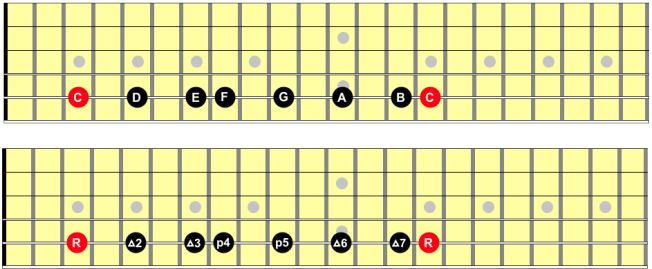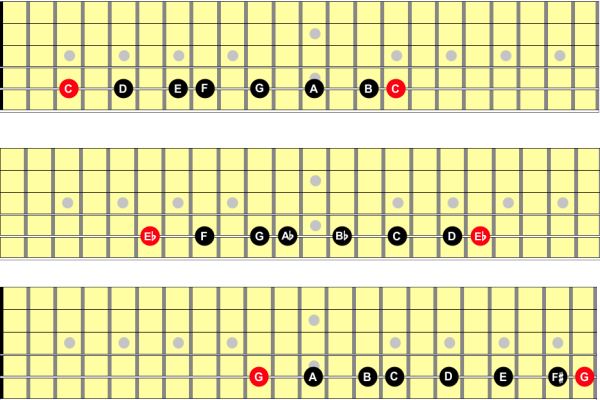The Major Scale – The Most Important Music Theory You'll Ever Learn!
In the vast landscape of music theory, few concepts are as fundamental and omnipresent as the major scale.
Its significance extends far beyond a mere sequence of notes; it serves as the cornerstone of Western music theory (all other theory comes comparing how other combinations of notes differ from
the major scale) and is indispensable to musicians across genres and styles.
This article delves into the major scale's construction and it's importance to the world of music.
Let's get started!
Find this website helpful? Click the button to show your support.
Major Scale Origins:
The major scale, also known as the Ionian mode, is a sequence of seven notes that follow a specific pattern of whole and half steps. Its construction dates back centuries, evolving through the works of ancient Greek musicians and theorists.
The modern major scale is characterized by its intervals (the spaces between notes), which consist of a whole step between each successive note except between the 3rd and 4th, and the 7th and 8th (which forms a half step).
On the guitar, a whole step is made up of two frets. A half step is made up of 1 fret between notes.
The Major Scale Formula:
The formula for constructing a major scale is:
W-W-H-W-W-W-H
Where 'W' represents a whole step and 'H' represents a half step.
For example, in the key of C major, starting from the root note C, the scale follows the pattern:
C-D-E-F-G-A-B-C
We can also identify the notes of a major scale by giving each note a number that corresponds with where it occurs in the scale; for example the Root or the 1, the 2nd, 3rd, etc. Have a look at the following 2 fretboard diagrams and take note of:
- the spaces between the notes
- how the note names and numercal identifiers correspond

Major Scale Musical Properties:
Tonal Center:
The major scale establishes a tonal center, known as the tonic, around which melodies and harmonies revolve. This stable point provides a sense of resolution and serves as a reference for musical compositions.
It's important to realize that a chord can be built off of each of the 7 notes of the major scale, and these chords can also be called by the numerical identifier of their root note.
For instance its common to hear musicians say “this song is a 1-4-5 chord progression in C.” Looking at the charts above, we can see that C is the 1... F is the 4... and G is the 5. So a 1-4-5 chord progression in the key of C has the chords C major, F major and G major.
Harmonic Function:
As we saw above, the notes of the major scale form the basis for constructing chords, which are essential building blocks in harmony. Each degree of the scale corresponds to a specific chord quality, such as major, minor, or diminished, enabling musicians to create rich harmonic progressions.
Here are the chords in the key of C:
◦ I chord – Major C Major
◦ ii chord – Minor D minor
◦ iii chord – Minor E minor
◦ IV chord – Major F Major
◦ V chord – Major G Major
◦ vi chord – Minor A minor
◦ vii chord – Diminished B diminished
Melodic Function:
Melodies often adhere to the notes of the major scale, utilizing its intervals to create memorable and pleasing sequences of pitches. Its balanced structure lends itself well to a wide range of musical expressions, from joyful anthems to poignant ballads.
Transposability:
One of the major scale's remarkable attributes is its transposability. By applying the same intervallic pattern starting from a different note, musicians can generate major scales in all twelve keys, facilitating versatility and exploration in composition and performance.
Here are 3 fretboard diagrams showing 3 DIFFERENT major scales – C, Eb and G... but notice the formula of the intervals are all the same!!!

Importance in Music Theory:
The major scale serves as the foundation upon which much of Western music theory is built. Its predictable structure and harmonic implications form the basis for understanding chord progressions, modulation, and tonal relationships. Mastery of the major scale is often a prerequisite for delving into more advanced concepts such as modes, counterpoint, and chromatic harmony.
Furthermore, the major scale's use extends beyond classical and traditional music genres. It can be found in jazz, pop, rock, blues, and virtually every other style, providing a common language for musicians to communicate and collaborate. Whether improvising a jazz solo, crafting a catchy pop hook, or composing a symphony, knowledge of the major scale is indispensable.
The major scale stands as a testament to the enduring significance of fundamental musical concepts. Its elegant structure, harmonic richness, and universal applicability make it an indispensable tool for musicians of all levels and genres.
By understanding and mastering the major scale, musicians unlock a world of creative possibilities, enriching their musical journey and connecting with audiences on a profound level.
Here are a couple of YouTube videos I've done on the Major scale – enjoy and best wishes for your guitar playing endeavors!!
The Major Scale Explained For Guitarists
The Perfect Major Scale Exercise For Guitar
